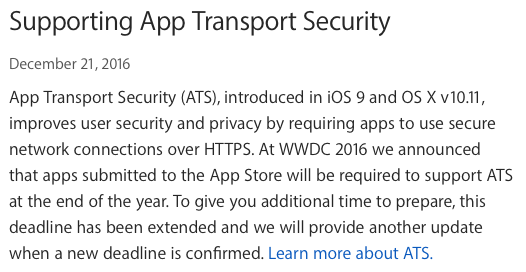
首先来分析一下什么是HTTPS以及了解HTTPS对于iOS开发者的意义
HTTPS 以及SSL/TSL
- 什么是SSL?
SSL(Secure Sockets Layer, 安全套接字层),因为原先互联网上使用的 HTTP 协议是明文的,存在很多缺点,比如传输内容会被偷窥(嗅探)和篡改。 SSL 协议的作用就是在传输层对网络连接进行加密。
- 何为TLS?
到了1999年,SSL 因为应用广泛,已经成为互联网上的事实标准。IETF 就在那年把 SSL 标准化。标准化之后的名称改为 TLS(Transport Layer Security,传输层安全协议)。SSL与TLS可以视作同一个东西的不同阶段
- HTTPS
简单来说,HTTPS = HTTP + SSL/TLS, 也就是 HTTP over SSL 或 HTTP over TLS,这是后面加 S 的由来 。
HTTPS和HTTP异同:HTTP和HTTPS使用的是完全不同的连接方式,用的端口也不一样,前者是80,后者是443。HTTP的连接很简单,是无状态的;HTTPS协议是由SSL+HTTP协议构建的可进行加密传输、身份认证的网络协议,比HTTP协议安全。
在WWDC 2016开发者大会上,苹果宣布了一个最后期限:到2017年1月1日 App Store中的所有应用都必须启用 App Transport Security安全功能。App Transport Security(ATS)是苹果在iOS 9中引入的一项隐私保护功能,屏蔽明文HTTP资源加载,连接必须经过更安全的HTTPS。苹果目前允许开发者暂时可以继续使用HTTP连接,但到年底所有官方商店的应用都必须强制性使用ATS。
以下是开发者网站公告原文:
2016年12月21日苹果更新了截止日期,宣布延期执行ATS支持要求Supporting App Transport Security。

** 此举为开发者提供了更多时间来做适配和支持。然而,对于iOS开发者来说,尽早解决HTTPS请求的问题仍为上策。**
苹果ATS对HTTPS证书的要求
- 服务器所有的连接使用TLS1.2以上版本
- HTTPS证书必须使用SHA256以上哈希算法签名
- HTTPS证书必须使用RSA 2048位或ECC 256位以上公钥算法
- 使用前向加密技术
此外,苹果ATS支持CT证书透明,要求开发者使用支持CT证书透明度的SSL证书,确保SSL证书合法透明,防止中间人攻击。
发送HTTPS请求信任SSL证书和自签名证书,分为三种情况
1.如果你的app服务端安装的是SLL颁发的CA,可以使用系统方法直接实现信任SSL证书,关于Apple对SSL证书的要求请参考:苹果官方文档CertKeyTrustProgGuide
这种方式不需要在Bundle中引入CA文件,可以交给系统去判断服务器端的证书是不是SSL证书,验证过程也不需要我们去具体实现。
示例代码:
NSURL *URL = [NSURL URLWithString:URLString];
NSURLRequest *request = [[NSURLRequest alloc] initWithURL:URL cachePolicy:NSURLRequestReloadIgnoringLocalCacheData timeoutInterval:10];
//创建同步连接
NSError *error = nil;
NSData *receivedData = [NSURLConnection sendSynchronousRequest:request returningResponse:nil error:&error];
NSString *receivedInfo = [[NSString alloc] initWithData:receivedData encoding:NSUTF8StringEncoding];
2.基于AFNetWorking的SSL特定服务器证书信任处理,重写AFNetWorking的customSecurityPolicy方法,这里我创建了一个HttpRequest类,分别对GET和POST方法进行了封装,以GET方法为例:
+ (void)get:(NSString *)url params:(NSDictionary *)params success:(void (^)(id))success failure:(void (^)(NSError *))failure {
// 1.获得请求管理者
AFHTTPRequestOperationManager *mgr = [AFHTTPRequestOperationManager manager];
// 2.申明返回的结果是text/html类型
mgr.responseSerializer = [AFHTTPResponseSerializer serializer];
// 3.设置超时时间为10s
mgr.requestSerializer.timeoutInterval = 10;
// 加上这行代码,https ssl 验证。
if(openHttpsSSL) {
[mgr setSecurityPolicy:[self customSecurityPolicy]];
}
// 4.发送GET请求
[mgr GET:url parameters:params success:^(AFHTTPRequestOperation *operation, id responseObj){
if (success) {
success(responseObj);
}
} failure:^(AFHTTPRequestOperation *operation, NSError *error) {
if (error) {
failure(error);
}
}];
}
+ (AFSecurityPolicy*)customSecurityPolicy {
// /先导入证书
NSString *cerPath = [[NSBundle mainBundle] pathForResource:certificate ofType:@"cer"];//证书的路径
NSData *certData = [NSData dataWithContentsOfFile:cerPath];
// AFSSLPinningModeCertificate 使用证书验证模式
AFSecurityPolicy *securityPolicy = [AFSecurityPolicy policyWithPinningMode:AFSSLPinningModeCertificate];
// allowInvalidCertificates 是否允许无效证书(也就是自建的证书),默认为NO
// 如果是需要验证自建证书,需要设置为YES
securityPolicy.allowInvalidCertificates = YES;
//validatesDomainName 是否需要验证域名,默认为YES;
//假如证书的域名与你请求的域名不一致,需把该项设置为NO;如设成NO的话,即服务器使用其他可信任机构颁发的证书,也可以建立连接,这个非常危险,建议打开。
//置为NO,主要用于这种情况:客户端请求的是子域名,而证书上的是另外一个域名。因为SSL证书上的域名是独立的,假如证书上注册的域名是www.google.com,那么mail.google.com是无法验证通过的;当然,有钱可以注册通配符的域名*.google.com,但这个还是比较贵的。
//如置为NO,建议自己添加对应域名的校验逻辑。
securityPolicy.validatesDomainName = NO;
securityPolicy.pinnedCertificates = @[certData];
return securityPolicy;
}
其中的cerPath就是app bundle中证书路径,certificate为证书名称的宏,仅支持cer格式,securityPolicy的相关配置尤为重要,请仔细阅读customSecurityPolicy方法并根据实际情况设置其属性。
这样,就能够在AFNetWorking的基础上使用HTTPS协议访问特定服务器,但是不能信任根证书的CA文件,因此这种方式存在风险,读取pinnedCertificates中的证书数组的时候有可能失败,如果证书不符合,certData就会为nil。
3.更改系统方法,发送异步NSURLConnection请求。
- (void)getDataWithURLRequest {
//connection
NSString *urlStr = @"https://developer.apple.com/cn/";
NSURL *url = [NSURL URLWithString:urlStr];
NSMutableURLRequest *request = [NSMutableURLRequest requestWithURL:url cachePolicy:NSURLRequestUseProtocolCachePolicy timeoutInterval:10];
NSURLConnection *connection = [[NSURLConnection alloc]initWithRequest:request delegate:self];
[connection start];
}
重点在于处理NSURLConnection的didReceiveAuthenticationChallenge代理方法,对CA文件进行验证,并建立信任连接。
- (BOOL)connection:(NSURLConnection *)connection canAuthenticateAgainstProtectionSpace:(NSURLProtectionSpace *)protectionSpace {
return [protectionSpace.authenticationMethod isEqualToString:NSURLAuthenticationMethodServerTrust];
}
- (void)connection:(NSURLConnection *)connection didReceiveAuthenticationChallenge:(NSURLAuthenticationChallenge *)challenge {
/*
//直接验证服务器是否被认证(serverTrust),这种方式直接忽略证书验证,直接建立连接,但不能过滤其它URL连接,可以理解为一种折衷的处理方式,实际上并不安全,因此不推荐。
SecTrustRef serverTrust = [[challenge protectionSpace] serverTrust];
return [[challenge sender] useCredential: [NSURLCredential credentialForTrust: serverTrust]
forAuthenticationChallenge: challenge];
*/
if ([[[challenge protectionSpace] authenticationMethod] isEqualToString: NSURLAuthenticationMethodServerTrust]) {
do
{
SecTrustRef serverTrust = [[challenge protectionSpace] serverTrust];
NSCAssert(serverTrust != nil, @"serverTrust is nil");
if(nil == serverTrust)
break; /* failed */
/**
* 导入多张CA证书(Certification Authority,支持SSL证书以及自签名的CA)
*/
NSString *cerPath = [[NSBundle mainBundle] pathForResource:@"cloudwin" ofType:@"cer"];//自签名证书
NSData* caCert = [NSData dataWithContentsOfFile:cerPath];
NSString *cerPath2 = [[NSBundle mainBundle] pathForResource:@"apple" ofType:@"cer"];//SSL证书
NSData * caCert2 = [NSData dataWithContentsOfFile:cerPath2];
NSCAssert(caCert != nil, @"caCert is nil");
if(nil == caCert)
break; /* failed */
NSCAssert(caCert2 != nil, @"caCert2 is nil");
if (nil == caCert2) {
break;
}
SecCertificateRef caRef = SecCertificateCreateWithData(NULL, (__bridge CFDataRef)caCert);
NSCAssert(caRef != nil, @"caRef is nil");
if(nil == caRef)
break; /* failed */
SecCertificateRef caRef2 = SecCertificateCreateWithData(NULL, (__bridge CFDataRef)caCert2);
NSCAssert(caRef2 != nil, @"caRef2 is nil");
if(nil == caRef2)
break; /* failed */
NSArray *caArray = @[(__bridge id)(caRef),(__bridge id)(caRef2)];
NSCAssert(caArray != nil, @"caArray is nil");
if(nil == caArray)
break; /* failed */
OSStatus status = SecTrustSetAnchorCertificates(serverTrust, (__bridge CFArrayRef)caArray);
NSCAssert(errSecSuccess == status, @"SecTrustSetAnchorCertificates failed");
if(!(errSecSuccess == status))
break; /* failed */
SecTrustResultType result = -1;
status = SecTrustEvaluate(serverTrust, &result);
if(!(errSecSuccess == status))
break; /* failed */
NSLog(@"stutas:%d",(int)status);
NSLog(@"Result: %d", result);
BOOL allowConnect = (result == kSecTrustResultUnspecified) || (result == kSecTrustResultProceed);
if (allowConnect) {
NSLog(@"success");
}else {
NSLog(@"error");
}
/* https://developer.apple.com/library/ios/technotes/tn2232/_index.html */
/* https://developer.apple.com/library/mac/qa/qa1360/_index.html */
/* kSecTrustResultUnspecified and kSecTrustResultProceed are success */
if(! allowConnect)
{
break; /* failed */
}
#if 0
/* Treat kSecTrustResultConfirm and kSecTrustResultRecoverableTrustFailure as success */
/* since the user will likely tap-through to see the dancing bunnies */
if(result == kSecTrustResultDeny || result == kSecTrustResultFatalTrustFailure || result == kSecTrustResultOtherError)
break; /* failed to trust cert (good in this case) */
#endif
// The only good exit point
return [[challenge sender] useCredential: [NSURLCredential credentialForTrust: serverTrust]
forAuthenticationChallenge: challenge];
} while(0);
}
// Bad dog
return [[challenge sender] cancelAuthenticationChallenge: challenge];
}
这里的关键在于result参数的值,根据官方文档的说明,判断(result == kSecTrustResultUnspecified) || (result == kSecTrustResultProceed)的值,若为1,则该网站的CA被app信任成功,可以建立数据连接,这意味着所有由该CA签发的各个服务器证书都被信任,而访问其它没有被信任的任何网站都会连接失败。该CA文件既可以是SLL也可以是自签名。
NSURLConnection的其它代理方法实现
#pragma mark -- connect的异步代理方法
-(void)connection:(NSURLConnection *)connection didReceiveResponse:(NSURLResponse *)response {
NSLog(@"请求被响应");
_mData = [[NSMutableData alloc]init];
}
-(void)connection:(NSURLConnection *)connection didReceiveData:(nonnull NSData *)data {
NSLog(@"开始返回数据片段");
[_mData appendData:data];
}
-(void)connectionDidFinishLoading:(NSURLConnection *)connection {
NSLog(@"链接完成");
//可以在此解析数据
NSString *receiveInfo = [NSJSONSerialization JSONObjectWithData:self.mData options:NSJSONReadingAllowFragments error:nil];
NSLog(@"received data:\\\\n%@",self.mData);
NSLog(@"received info:\\\\n%@",receiveInfo);
}
//链接出错
-(void)connection:(NSURLConnection *)connection didFailWithError:(NSError *)error {
NSLog(@"error - %@",error);
}
至此,HTTPS信任证书的问题得以解决,这不仅是为了响应Apple强制性使用ATS的要求,也是为了实际生产环境安全性的考虑,HTTPS是未来的趋势,建议尽早支持。
如需参考Demo请移步本人在Github上的开源项目










